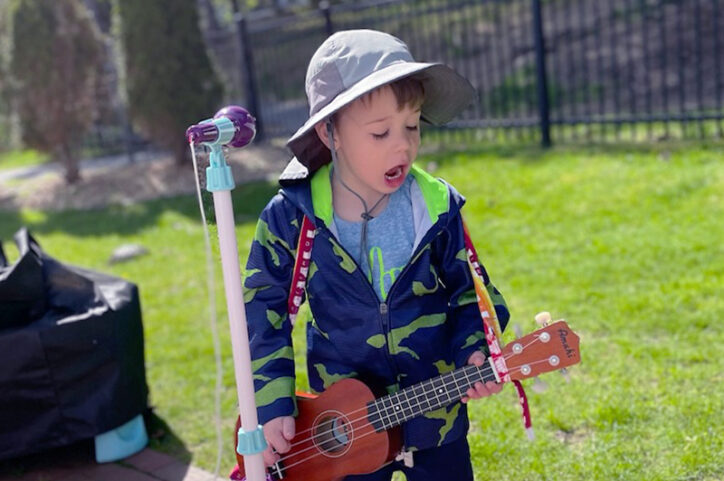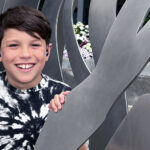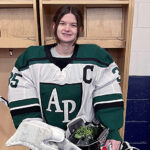Learning to speak with the help of a bone-anchored hearing system: Owen’s story

Why does 4-year-old Owen love Ghost Spider? For one thing, her suit has purple highlights. For another, her hand forms the sign for ‘I love you’ whenever she casts a web. These reasons say a lot about Owen: a loving kid who knows American Sign Language (ASL) and whose favorite color is purple.
For several years, ASL was Owen’s main form of communication. Born with a form of microtia, a birth defect in which the ear is not fully formed, he started wearing a bone-anchored hearing system when he was 9 months old. Since then, the device has helped him hear and learn spoken language.
What microtia meant for Owen
When Owen was four weeks old, he and his parents, Lexie and Dan, had their first appointment with Boston Children’s Department of Otolaryngology and Communication Enhancement. They’d scheduled the visit shortly after Owen’s birth, after a doctor discovered that his left ear didn’t open to an ear canal. Even though some children with microtia don’t have hearing loss, it became clear that Owen did when he failed a newborn hearing test.

The news was just starting to sink in when the family met with Dr. Margaret Kenna for the first time. “I had a whole list of questions,” says Lexie. Her top concern was whether Owen would need surgery. She’d heard about a procedure to create an opening to the ear canal — should they consider it for Owen?
Dr. Kenna explained that she didn’t strongly recommend the procedure because of its inherent risks and low success rate. “It made me feel better to know that surgery wasn’t an option we were going to pursue for Owen,” says Lexie. “I could stop worrying about making that decision.”
Owen wouldn’t need plastic surgery either. Unlike some babies with microtia, he had an external ear, although it was slightly misshapen. For this, Dr. Carolyn Rogers-Vizena of the Cleft and Craniofacial Center referred him for ear molding. The process involved placing a round plastic form along his ear, taking advantage of the brief period before the cartilage matured and became set, to mold his ear into a more traditional shape.
Sound vibrations with bone-anchored hearing
With surgery ruled out, his parents discussed other options with his team in the Audiology Program. “We wanted to give him the best possible access to sound,” says Lexie. Hearing is essential to spoken language skills, but a traditional hearing aid, that transmits sound through the ear canal, wouldn’t work for Owen. Instead, Dr. Kenna suggested a bone-anchored hearing system.
It was reassuring to work with a team we trusted. We didn’t have to second guess their recommendations — we knew they saw Owen as a whole person.”
Bone-anchored hearing systems send sound vibrations directly to the inner ear, bypassing any deformities in the ear canal that limit the transmission of sound. The device would be held in place on Owen’s head by a softband that could be put on and taken off.
A slow but sure start at language skills
Soon after he started wearing the bone-anchored hearing system, Owen started babbling and making noise. But he didn’t develop speech and language skills right away. So, when he was 15 months old, he started speech therapy with early intervention. He also started to learn ASL.
Lexie and Dan, who had started learning ASL a few months after Owen was born, used both spoken language and sign language with him as he got older. These efforts seemed to feed Owen’s growing desire to communicate. By the time he was 3, even though he only knew about 30 spoken words, he knew 250 words in sign.
“Our biggest priority was giving Owen access to language,” says Dan. “ASL gave him that early on.”
Last winter, Owen started mixing the two, signing half of a sentence and speaking the rest. As he spoke more words and signed less, his parents decided to place him in a mainstream kindergarten program. “It was time,” says Lexie.

‘Part of your kid’
When he gets older, Owen might decide he wants a surgically implanted bone-anchored hearing system, but his parents are leaving that choice up to him. For now, he enjoys choosing which of his many colorful softbands to wear each day and gets to pick a new softband whenever he visits audiologist Shannon Hamill.
When she speaks to other parents, Lexie is quick to reassure them that raising a child with hearing loss may seem overwhelming at first, “but over time, you realize it’s just a part of your kid.” Being able to communicate with Owen early on through ASL helped, as did the team at Boston Children’s.
“It was reassuring to work with a team we trusted. We didn’t have to second guess their recommendations — we knew they saw Owen as a whole person.”
Learn more about the Bone-Anchored Hearing Program, Audiology Program, and Cleft and Craniofacial Center.
Related Posts :
-

How hearing aids opened up a world of sound for Harry
Maybe it’s unusual to bring a musical instrument to an audiology appointment, but that didn’t stop Harry King. ...
-

Overcoming microtia, atresia, and speech challenges: Braelyn’s story
Eight-year-old Braelyn is a sweet, confident kid who loves everyone, dotes on her little sister Kamryn, does well in school, ...
-

How I hear you: Isabelle’s cochlear implant story
Isabelle is a thriving AP student, hockey player, and online gamer who listens to music and communicates with the help ...
-

A different kind of hearing: Caleb’s cochlear implant
Caleb recently told his mother, “I think I’m going to write my own stories.” This news didn’t surprise ...





